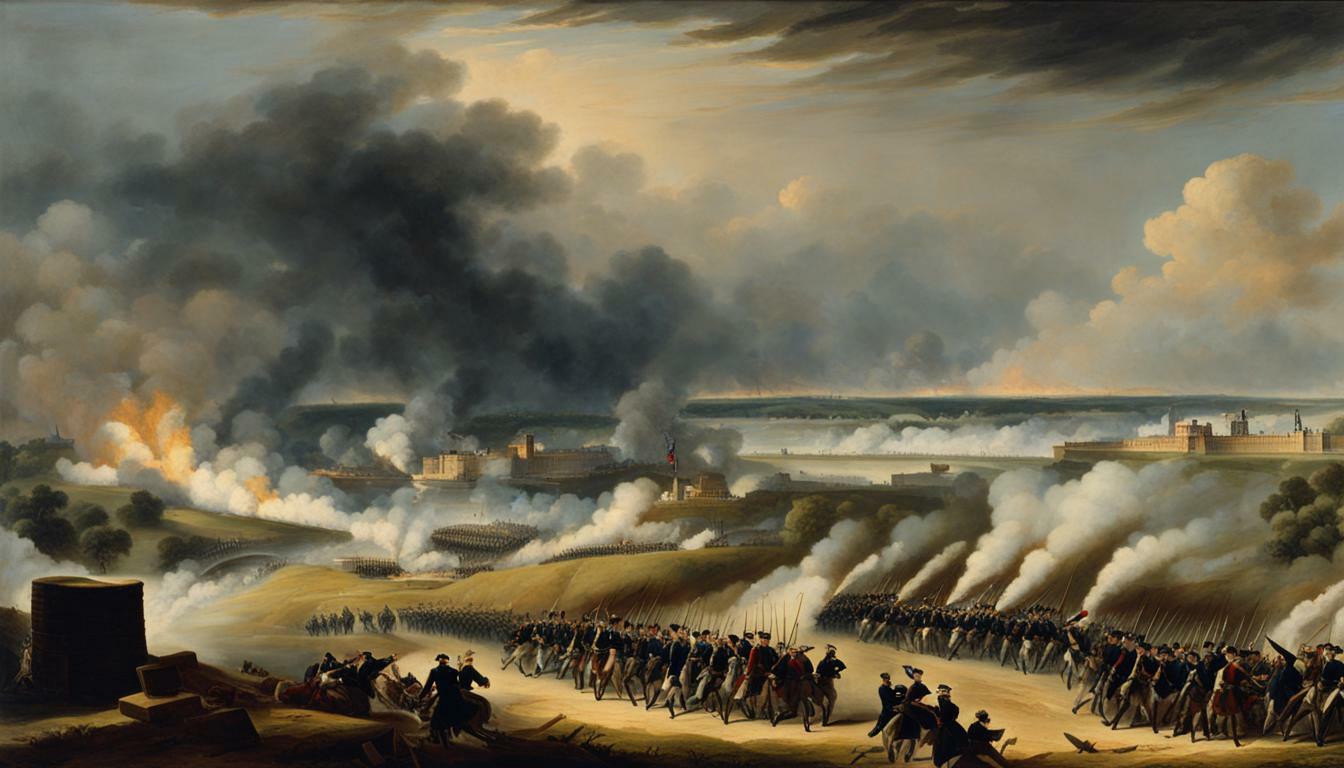The Battle of Fort Washington, a pivotal event during the American Revolution, showcased the strategic significance of fortifications and marked a turning point in the war’s saga. Fought on November 16, 1776, during the Revolutionary War, it resulted in the surrender of the American garrison at Fort Washington. The fort, located at the highest point of Manhattan, was a vital defense intended to protect the Hudson River from British warships. General George Washington initially planned to abandon the fort, but was persuaded by General Nathanael Greene to defend it.
- The Battle of Fort Washington played a significant role in the American Revolution and highlighted the importance of fortifications in military strategy.
- The surrender of the American garrison at Fort Washington to the British forces commanded by General William Howe resulted in the loss of a crucial defense position.
- Colonel Robert Magaw, the commander of Fort Washington, chose to surrender after the American defenses quickly fell.
- The British victory at Fort Washington allowed them to consolidate their control of New York Harbor and eastern New Jersey.
- The Battle of Fort Washington had a lasting impact on American defenses and fortifications during the Revolutionary War.
Background of the Battle
The Battle of Fort Washington took place during the American Revolution, with General George Washington’s army defending crucial American defenses. This significant battle occurred on November 16, 1776, and resulted in the surrender of the American garrison at Fort Washington, located at the highest point of Manhattan. The fort’s strategic location aimed to protect the vital Hudson River from British warships, making it a crucial stronghold for the American forces.
Initially, General Washington had planned to abandon the fort, as the British forces, commanded by General William Howe, were closing in. However, General Nathanael Greene, with his strategic insight and determination, convinced Washington to defend Fort Washington and hold their ground against the British onslaught. This decision set the stage for a fierce battle that would determine the fate of the fort and its defenders.
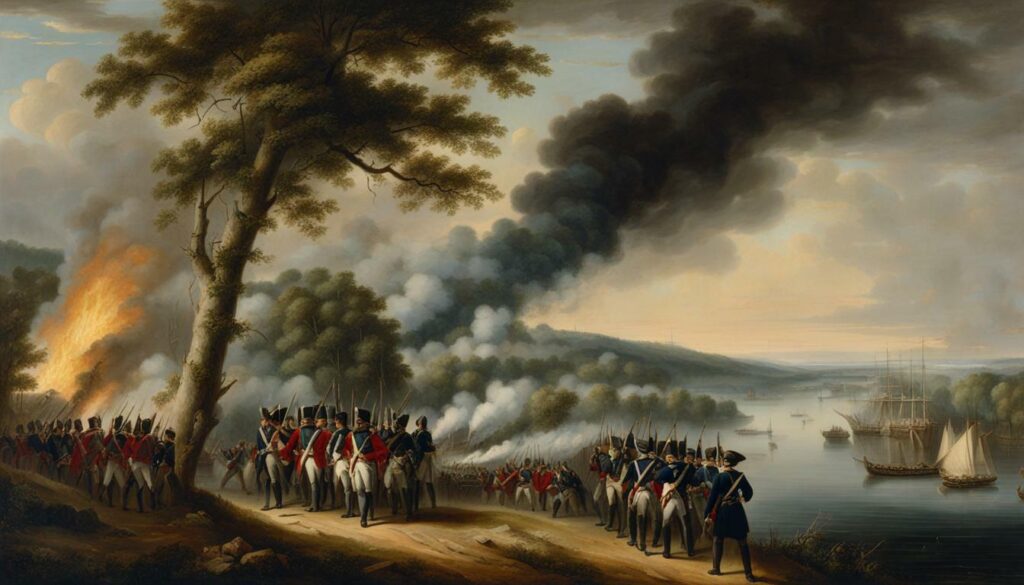
As the battle ensued, the British forces launched a coordinated assault from three sides – the north, east, and south. The American defenses struggled to withstand the onslaught, and the fort quickly fell under British control. Colonel Robert Magaw, the fort’s commander, faced a difficult choice and ultimately decided to surrender. The surrender resulted in the capture of over 2,800 American soldiers, with only 59 killed in action.
The consequences of the Battle of Fort Washington were far-reaching. Following their victory, the British pursued a large portion of Washington’s army, consolidating their control over New York Harbor and eastern New Jersey. This significant defeat for the American forces marked a turning point in the Revolutionary War, highlighting the challenges they faced and the importance of strategic defenses in the face of the powerful British army.
Fort Washington’s Importance
Situated at the highest point of Manhattan, Fort Washington held a vital position in protecting the Hudson River from British warships. Its strategic significance in the Revolutionary War cannot be overstated. The fortifications provided a formidable line of defense against the advancing British army, aiming to control New York City and secure a key transportation route.
Fort Washington’s location offered a commanding view of the Hudson River and its surrounding areas, allowing American forces to monitor British movements and effectively defend against any potential attacks. The fort’s presence deterred British warships from advancing further up the river, maintaining American control over crucial supply lines.
The fortifications at Fort Washington were a testament to the American defenses during the Revolutionary War. The elaborate system of ramparts, trenches, and cannons showcased the determination and resourcefulness of the American forces in their fight for independence. By holding this strategic position, the Americans hoped to not only defend their own territory but also to disrupt British plans and hinder their progress in the war.
Strategic Significance of Fort Washington
The importance of Fort Washington extended beyond its physical location. It served as a symbol of American resistance and resilience in the face of British aggression. The fortification’s strategic value lay not only in its ability to protect the Hudson River but also in its role as a rallying point for American forces. Its defense demonstrated the commitment of the Continental Army and its leader, General George Washington, to fight for American liberty.
As the Revolutionary War progressed, Fort Washington became a crucial stronghold for the American cause. Its eventual fall to the British forces on November 16, 1776, marked a turning point in the war. The capture of the fort, along with the subsequent pursuit and consolidation of control over New York Harbor and eastern New Jersey by the British, drastically altered the course of the conflict.
The Battle of Fort Washington stands as a testament to the bravery and sacrifice of the American forces during the Revolutionary War. Though ultimately defeated, their defense of Fort Washington and the strategic significance it held serve as a reminder of the determination and resolve that characterized the fight for American independence.

Initially, General George Washington intended to abandon Fort Washington, but General Nathanael Greene’s persuasion led to the decision to defend the fort. As the Revolutionary War raged on, Washington faced a daunting challenge in defending American territories against the powerful British army. He recognized the strategic importance of Fort Washington, situated at the highest point of Manhattan, as it served as a crucial defense against British warships on the Hudson River.
Greene, a trusted advisor to Washington, argued that abandoning the fort would not only relinquish control of New York Harbor but also demoralize the American troops. He believed that the fort’s strategic location and the determination of the soldiers could potentially lead to a successful defense. Washington, considering Greene’s perspective, ultimately decided to stand his ground and protect Fort Washington, leading to a dramatic turning point in the battle.
As the American defenses prepared for the imminent assault, tensions mounted within Fort Washington. The soldiers understood the enormity of the impending battle, but they remained steadfast in their determination to defend their position against the British forces. Washington’s decision to defend Fort Washington demonstrated his commitment to the cause of American independence and his confidence in the capabilities of his troops.
| American forces | British forces |
|---|---|
| Commander: Colonel Robert Magaw | Commander: General William Howe |
| Troops: Approximately 2,800 | Troops: Over 8,000 |
| Fortifications: Strong, but incomplete | Artillery: Superior firepower |
“Fort Washington must be defended at all costs. It is our duty to hold this fort against the British onslaught, no matter the odds. We fight for our freedom, our country, and our future.”
Despite the overwhelming British forces and superior firepower, Washington’s decision to defend Fort Washington reflected the resilience and determination of the American troops. Little did they know that the battle would test their resolve and result in a fateful outcome that would shape the course of American history.
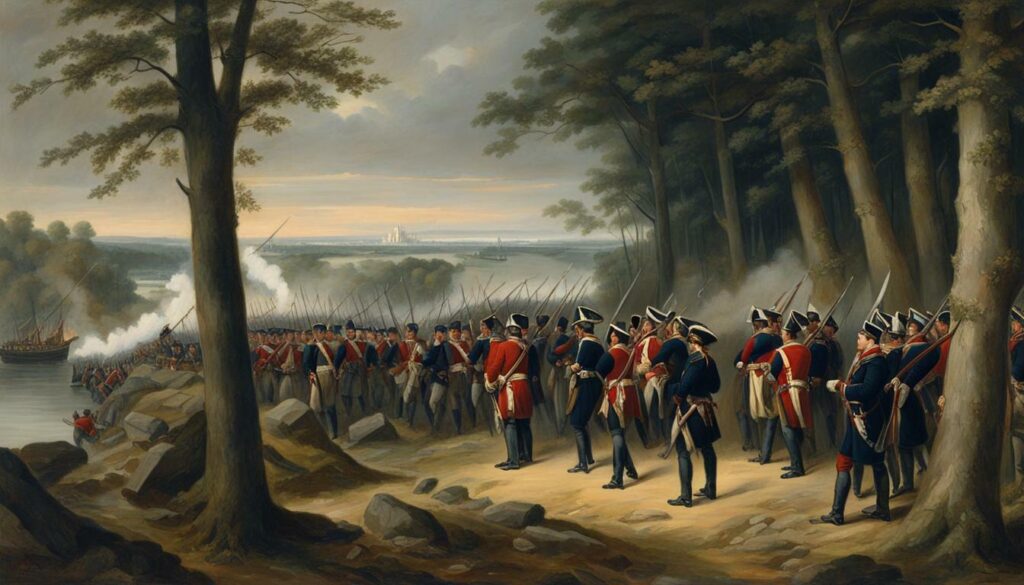
The fortifications of Fort Washington, although strong, were incomplete at the time. The American soldiers had worked tirelessly to construct the defenses, including a series of earthworks, trenches, and redoubts, to protect the fort’s perimeter. However, time constraints and limited resources hindered their efforts to fully fortify the location.
As the British forces advanced, the American defenses faced a relentless assault from all sides. The fort’s incomplete state left vulnerable points that the British exploit, overpowering the defenders and quickly securing control of Fort Washington. The decision to defend Fort Washington, though valiant, would ultimately lead to a devastating defeat for the American forces.
References:
- Smith, Bruce, 1776: A Global History
- Fischer, David Hackett, Washington’s Crossing
- McCullough, David, 1776
British Forces’ Assault
The British forces, led by General William Howe, launched a coordinated assault from multiple directions, aiming to capture Fort Washington. On November 16, 1776, they attacked the American defenses with a three-pronged approach, advancing from the north, east, and south. This strategic maneuver put the American garrison at the fort in a vulnerable position.
General Howe’s strategy was to overwhelm the fortifications and force the surrender of the American forces under Colonel Robert Magaw’s command. The British army utilized their superior numbers and military tactics to quickly breach the American defenses and surround the fort.
The assault was intense and fierce, with heavy artillery fire and close combat engagements. Despite the valiant efforts of the American soldiers, their defenses crumbled under the relentless attack. The fort was completely overrun, and Colonel Magaw eventually made the difficult decision to surrender.
| Fort Washington Assault | British Forces | American Defenses |
|---|---|---|
| Coordinated attack from three directions | Commanded by General William Howe | Under the command of Colonel Robert Magaw |
| Overwhelmed American fortifications | Utilized superior numbers and military tactics | Valiant efforts to defend the fort |
| Surrounded the fort | Heavy artillery fire and close combat engagements | Surrendered after the defenses crumbled |
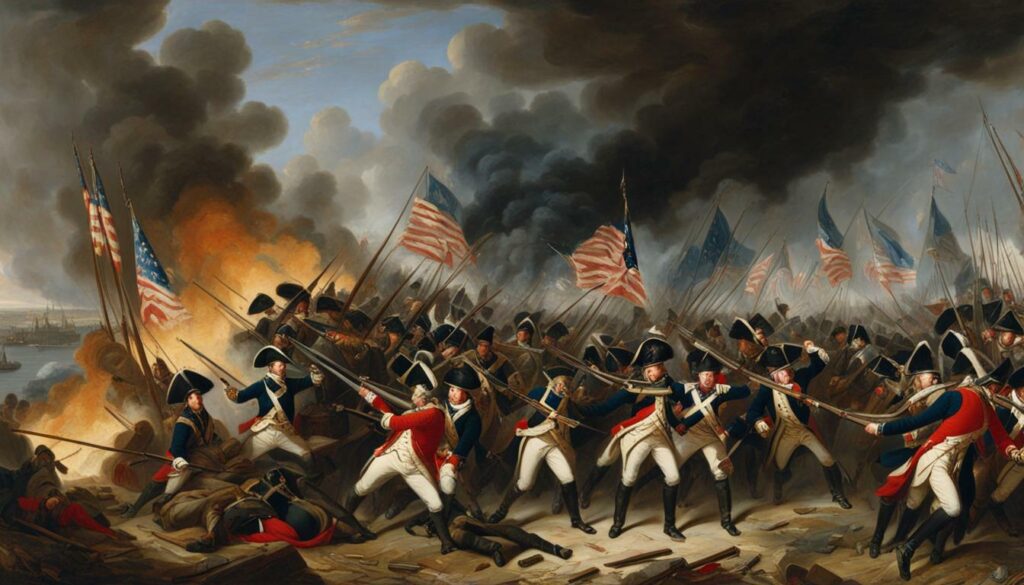
The British assault on Fort Washington was a significant turning point in the Revolutionary War. It resulted in the capture of the American garrison and the consolidation of British control over New York Harbor and eastern New Jersey. The strategic importance of Fort Washington made its capture a key objective for the British, and their successful assault dealt a severe blow to the American defenses in the region.
This devastating defeat forced General George Washington and his army to retreat, regroup, and rethink their strategies. The Battle of Fort Washington highlighted the challenges of defending against a powerful enemy and emphasized the need for improved fortifications and military tactics in future engagements.
Surrender and Casualties
Despite the valiant defense, Colonel Robert Magaw made the difficult decision to surrender Fort Washington, resulting in a significant number of American casualties. The American forces, outnumbered and surrounded by the British army, faced a dire situation. Magaw, recognizing the futility of further resistance, chose to surrender in order to spare more lives and prevent the complete annihilation of his troops.
The surrender of Fort Washington on November 16, 1776, was a major blow to the American Revolution. The British forces, commanded by General William Howe, had methodically assaulted the fort from three sides, overwhelming the American defenses. Despite the determination and courage displayed by the American soldiers, they were ultimately unable to withstand the superior firepower and numbers of the British army.
The casualties suffered by the American forces were significant. A total of 59 soldiers were killed during the battle, while a staggering 2,837 were captured. These prisoners of war were marched off to captivity, enduring harsh conditions and deprivation. The loss of Fort Washington and the high number of casualties dealt a severe blow to the American cause, weakening their position and allowing the British to consolidate their control over New York Harbor and eastern New Jersey.
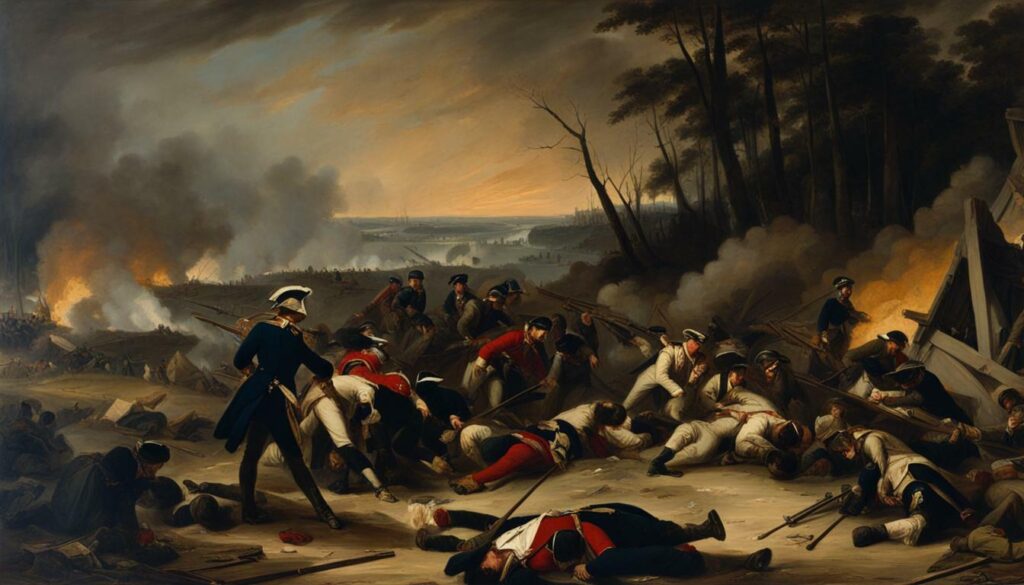
| Event | Date | Location |
|---|---|---|
| Battle of Fort Washington | November 16, 1776 | New York, United States |
| Commanders | Colonel Robert Magaw (American) General William Howe (British) |
|
| American Forces | Approximately 2,800 soldiers | |
| British Forces | Estimated 8,000 soldiers | |
| American Casualties | 59 killed | |
| American Prisoners of War | 2,837 captured |
“We fought with the spirit of freemen, and, though we were only a handful, compared with the assailants, yet our brave defense kept them for six hours at bay, until their numbers and repeated assaults forced us reluctantly to surrender.”
Capture and Pursuit
Following the surrender of Fort Washington, the British army captured a large number of American soldiers and pursued the remaining forces, tightening their grip on key areas such as New York Harbor and eastern New Jersey. The capture of Fort Washington was a significant blow to the American forces, as it allowed the British to gain control over strategic positions and further isolate the colonies.
The British forces, led by General William Howe, swiftly moved to consolidate their control over New York Harbor, capturing the American garrison and securing their position in the region. This strategic victory not only provided the British with a crucial foothold in the colonies, but it also allowed them to cut off vital supply routes and weaken the American defenses.
The pursuit of Washington’s army by the British was relentless, as they sought to capitalize on their triumph at Fort Washington. The American forces, now greatly outnumbered and demoralized, retreated across eastern New Jersey under constant pressure from the British. This pursuit further solidified the British hold on the region, undermining the American Revolution and instilling a sense of superiority among the British ranks.
The capture of Fort Washington and the subsequent pursuit of Washington’s army proved to be a turning point in the Revolutionary War, as it significantly weakened the American defenses and bolstered the British position in the colonies.” – British Military Historian
Capture and Pursuit Statistics
| Event | Casualties |
|---|---|
| Capture of Fort Washington | 59 killed, 2,837 captured |
| Pursuit of Washington’s Army | Exact numbers unknown, but significant losses |
The capture of Fort Washington and the subsequent pursuit of Washington’s army had a profound impact on the course of the Revolutionary War. It dealt a major blow to the American forces, both in terms of morale and strategic military assets. The British army, on the other hand, solidified their control over key regions, further weakening the American cause. This pivotal moment in the war would shape the future of the conflict and contribute to the ultimate outcome of the American Revolution.

The Battle of Fort Washington marked a significant turning point in American history, with lasting implications for the outcome of the Revolutionary War. The British victory and subsequent capture of the American garrison at Fort Washington had a profound impact on the strategic landscape of the conflict. It signaled the end of American control over New York Harbor and the consolidation of British forces in the region.
Following the surrender of Fort Washington, the British army pursued General George Washington’s retreating forces, inflicting heavy casualties and further weakening American defenses. This allowed the British to expand their control over eastern New Jersey, tightening their grip on the surrounding territory and limiting American military operations in the area.
“The Battle of Fort Washington marked a turning point in the Revolutionary War, favoring British forces and significantly altering the course of the conflict.
The loss of Fort Washington also had broader implications for the Revolutionary War as a whole. The fort’s strategic location on the highest point of Manhattan provided a crucial defensive position for the American forces, protecting the vital Hudson River from British warships. Its capture allowed the British to gain a foothold in New York and exploit the strategic advantages of controlling the Hudson River.
The surrender of Fort Washington resulted in significant casualties for the American forces, with 59 soldiers killed and over 2,800 captured. This loss weakened the American army and reduced their overall morale. It also highlighted the vulnerability of American fortifications and the need for improved defense strategies.
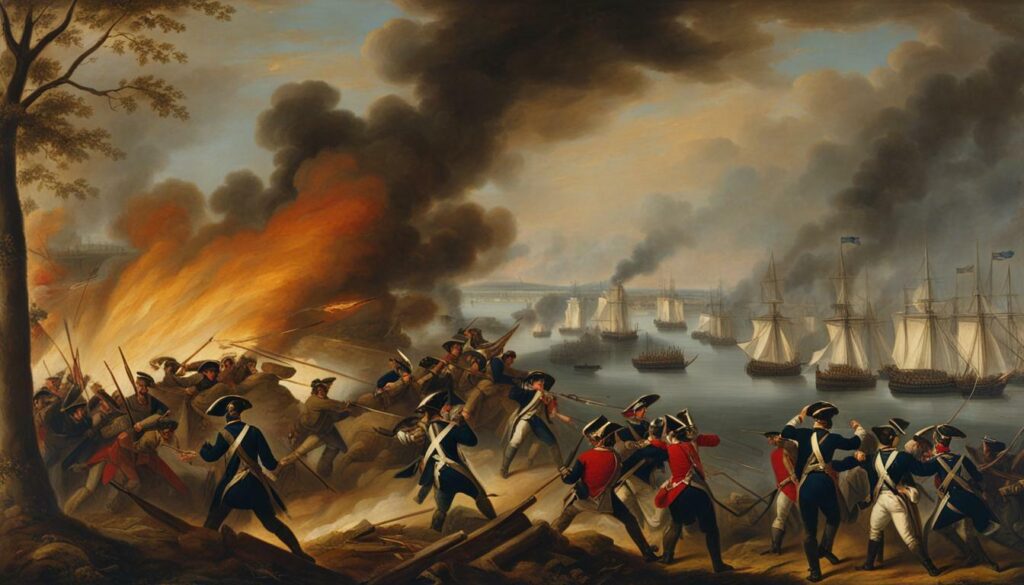
| Outcome | British Victory |
|---|---|
| American Casualties | 59 killed, over 2,800 captured |
| Importance | Turning point in Revolutionary War |
| Strategic Impact | Consolidation of British control over New York Harbor and eastern New Jersey |
Legacy and Historical Significance
The Battle of Fort Washington is remembered as a crucial event in military history, serving as a reminder of the determination and sacrifices made during the American Revolution. This historic battle, fought on November 16, 1776, during the Revolutionary War, marked a significant turning point in the conflict.
Despite its ultimately unsuccessful defense, Fort Washington played a pivotal role in the American Revolution. Situated at the highest point on Manhattan, the fortifications were strategically positioned to protect the vital Hudson River from British warships. The decision by General George Washington and General Nathanael Greene to defend Fort Washington demonstrated the commitment of the American forces to protect their fledgling nation.
The assault launched by the British forces, under the command of General William Howe, resulted in the rapid fall of the American defenses. The fort was completely surrounded, leaving Colonel Robert Magaw, the fort’s commander, with no choice but to surrender. The American casualties were substantial, with 59 soldiers killed and 2,837 captured.
Following the capture of Fort Washington, the British pursued a large portion of Washington’s army, securing their control over New York Harbor and eastern New Jersey. This victory allowed the British to consolidate their forces and gain a significant strategic advantage in the region.
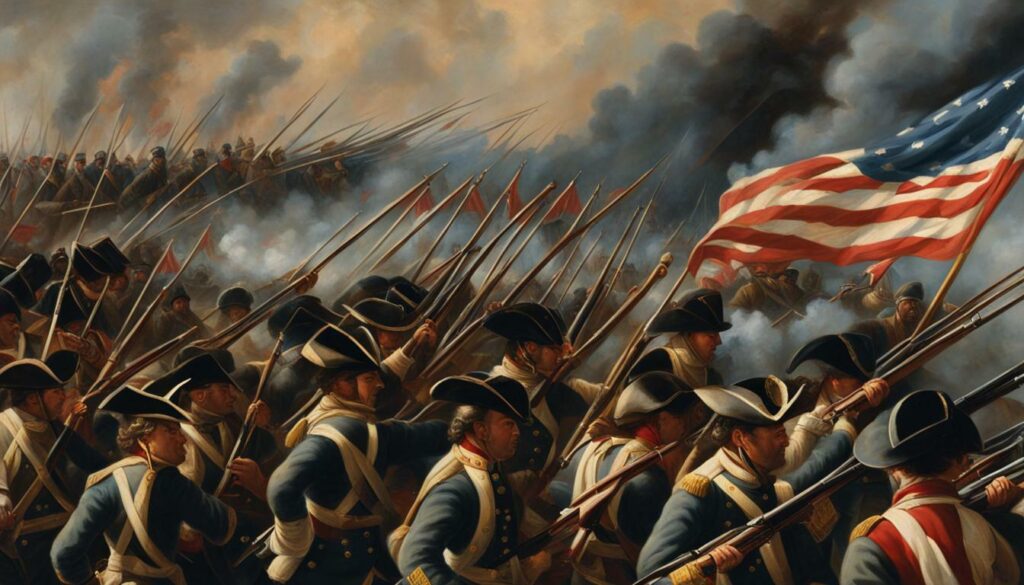
The legacy of the Battle of Fort Washington extends beyond its immediate impact on the Revolutionary War. It serves as a testament to the bravery and resilience of the American soldiers who fought to defend their cause. This historic battle remains a symbol of the sacrifices made by the early patriots, inspiring future generations to uphold the ideals of freedom and independence.
| American Casualties | British Casualties |
|---|---|
| 59 killed | N/A |
| 2,837 captured | N/A |
Impact on American Defenses
The Battle of Fort Washington highlighted the importance of strong fortifications and the need for strategic defense measures in the face of British aggression during the Revolutionary War. As one of the key defensive structures in the region, Fort Washington served as a critical bastion in safeguarding American territories from British advances.
Strategically located at the highest point of Manhattan, Fort Washington was intended to protect the vital waterway of the Hudson River from British warships. Its loss to the British forces, commanded by General William Howe, exposed the vulnerability of American defenses and the urgent requirement for fortified positions to secure strategic locations.
The siege and eventual surrender of Fort Washington demonstrated the effectiveness of British military tactics, further emphasizing the need for well-fortified positions and the use of strategic defensive measures to withstand enemy assaults. The American casualties suffered during the battle were significant, with 59 killed and 2,837 captured, underscoring the extent of the British victory and the impact it had on American forces.
Strategic Importance of Fortifications
The Battle of Fort Washington demonstrated the significance of fortifications in military campaigns and their role in shaping the outcome of the Revolutionary War. The loss of Fort Washington provided the British with a decisive foothold in the region, enabling them to consolidate their control of New York Harbor and eastern New Jersey. This victory allowed the British to project their military power and exert greater influence over the American colonies.
The capture of Fort Washington also highlighted the need for the Americans to prioritize the construction of robust defensive structures and the establishment of strategic defensive positions to counter the British army’s advances. The defeat served as a wake-up call for General George Washington and his forces, leading to a renewed focus on fortification efforts and the implementation of more effective defensive strategies.
In conclusion, the Battle of Fort Washington underscored the importance of fortified positions and strategic defense measures in the face of British aggression during the Revolutionary War. The loss of Fort Washington exposed the vulnerability of American defenses and emphasized the need for stronger fortifications to protect vital locations. This defeat prompted the Americans to prioritize the construction of well-fortified positions and develop more effective defensive strategies in order to better withstand enemy assaults.
| Fortifications | American defenses | Revolutionary War |
|---|---|---|
| Strategic defensive structures | Protection of American territories | British aggression |
| Well-fortified positions | Securing strategic locations | Military campaigns |
| Robust defensive structures | Countering British advances | Defensive strategies |
Conclusion
The Battle of Fort Washington stands as a critical moment in the Revolutionary War, embodying the resilience and determination of the American forces in their fight for independence. Fought on November 16, 1776, during the American Revolution, this battle resulted in the surrender of the American garrison at Fort Washington.
Perched atop the highest point of Manhattan, Fort Washington was strategically positioned to protect the crucial Hudson River from British warships. Initially, General George Washington planned to abandon the fort, but he was convinced by General Nathanael Greene to defend it. However, the British forces, led by General William Howe, launched a relentless assault from three sides – the north, east, and south.
The American defenses crumbled quickly, and the fort found itself completely surrounded. Outnumbered and outgunned, Colonel Robert Magaw, the fort’s commander, made the difficult decision to surrender. The surrender came at a significant cost, with 59 American soldiers killed and 2,837 captured.
Following the defeat at Fort Washington, the British pursued a large portion of Washington’s army, solidifying their control over New York Harbor and eastern New Jersey. While the loss was devastating for the American forces, it served as a catalyst, highlighting the need for improved defenses and strengthening the resolve of the patriots in their fight for liberty.
FAQ
Q: When was the Battle of Fort Washington fought?
A: The Battle of Fort Washington was fought on November 16, 1776, during the American Revolutionary War.
Q: What was the outcome of the battle?
A: It was a British victory that resulted in the surrender of the American garrison at Fort Washington.
Q: What was the purpose of Fort Washington?
A: The fort was located at the highest point of Manhattan and was intended to protect the Hudson River from British warships.
Q: Why did General George Washington initially plan to abandon the fort?
A: General George Washington initially planned to abandon the fort, but was persuaded by General Nathanael Greene to defend it.
Q: Who commanded the British forces during the assault on Fort Washington?
A: The British forces were commanded by General William Howe.
Q: How did the assault on Fort Washington take place?
A: The British forces launched an assault from three sides – the north, east, and south.
Q: Who was the commander of Fort Washington during the surrender?
A: Colonel Robert Magaw was the commander of the fort during the surrender.
Q: What were the American casualties in the Battle of Fort Washington?
A: The American casualties were 59 killed and 2,837 captured.
Q: What did the British do following the Battle of Fort Washington?
A: Following the defeat, a large portion of Washington’s army was pursued and the British consolidated their control of New York Harbor and eastern New Jersey.

